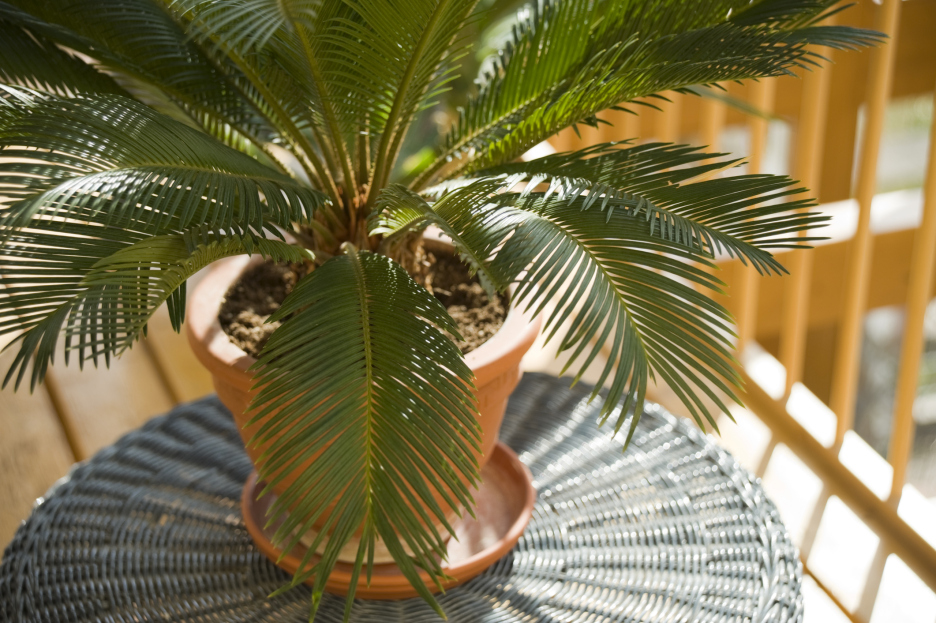
The Sago Palm (Cycas revoluta) is a unique and elegant plant that adds a touch of tropical flair to any home or garden. Despite its name, the Sago Palm is not a true palm but rather a type of cycad, an ancient group of plants that has been around for millions of years.
Known for its striking, feathery fronds and slow growth, the Sago Palm is a popular choice for both indoor and outdoor spaces. If you’re looking to care for this stunning plant, here’s everything you need to know to ensure it thrives in your home.
Sago Palms thrive in bright, indirect light but can also tolerate partial sunlight. Sago Palms do best when placed near a window that receives plenty of light throughout the day, but be cautious of direct sunlight, as it can scorch the leaves, causing them to turn brown. If you’re growing a Sago Palm indoors, an east- or west-facing window is ideal, as it provides bright light without the intensity of midday sun.
While the Sago Palm can tolerate low light conditions, its growth may slow down, and the plant may become leggy over time. If you notice that your plant is stretching or leaning toward the light, it may be a sign that it needs more brightness.
The Sago Palm is relatively drought-tolerant and does not require frequent watering. Overwatering is one of the most common mistakes when caring for a Sago Palm, as it can lead to root rot. It’s important to allow the soil to dry out between waterings.
Water your Sago Palm thoroughly when the top 1 to 2 inches of soil feel dry to the touch. Be sure to let excess water drain out of the pot, as standing water can cause the roots to become waterlogged. In the winter months, you can reduce the frequency of watering, as the plant’s growth slows down during this time.
Sago Palms prefer warm temperatures and are best suited for environments between 65°F and 85°F (18°C to 29°C). They are sensitive to cold temperatures and should be kept away from drafts, air conditioners, and heaters. If you live in a region with cold winters, it’s best to bring your Sago Palm indoors during the colder months.
Humidity is not a major concern for Sago Palms, as they are relatively adaptable to normal household humidity levels. However, if you live in a particularly dry climate, you can increase humidity by placing the plant on a humidity tray or using a humidifier.
Sago Palms prefer well-draining, sandy soil. A good potting mix for this plant should include a combination of potting soil, sand, and perlite or grit to ensure proper drainage. The plant’s roots do not like to sit in water, so make sure your pot has drainage holes to allow excess water to escape.
When repotting, choose a pot that is just one size larger than the current one. Sago Palms are slow growers and don’t need frequent repotting. Repotting every 2-3 years is usually sufficient, and it’s best done in the spring or early summer.
Sago Palms are not heavy feeders, but they will benefit from occasional fertilization. During its growing season (spring and summer), you can fertilize your Sago Palm once a month with a balanced, slow-release fertilizer. Choose a fertilizer with a balanced ratio, such as 10-10-10, and follow the instructions on the label to avoid over-fertilizing.
In the fall and winter, you can reduce fertilization or stop altogether, as the plant’s growth slows down during this period.
Sago Palms are low-maintenance plants, but occasional pruning can help keep them looking their best. Remove any dead or yellowing fronds by cutting them at the base with clean, sharp scissors or pruning shears. Avoid cutting healthy fronds, as this can harm the plant and reduce its aesthetic appeal.
If your Sago Palm has outgrown its pot, you can prune the roots during repotting to keep it contained in its new container. However, be sure not to remove too much of the root ball, as this can stress the plant.
No, the Sago Palm is toxic to pets. All parts of the plant, especially the seeds, contain cycasin, a toxin that can cause severe liver damage if ingested. Symptoms of poisoning in pets may include vomiting, diarrhea, lethargy, and loss of appetite. If you suspect your pet has ingested any part of a Sago Palm, contact your veterinarian immediately.
To keep your pets safe, place the Sago Palm in an area that is out of their reach, such as on a high shelf or in a room that your pets cannot access.